Fighting for Lincoln? Irish attitudes to slavery during the American Civil War
Published in 18th-19th Century Social Perspectives, 18th–19th - Century History, Features, Issue 3 May/June2013, Volume 21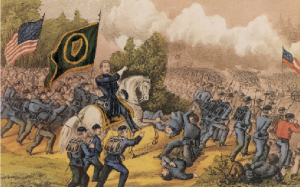
General Thomas Francis Meagher leading the bayonet charge of the Irish Brigade at the Battle of Fair Oaks, Virginia, 1 June 1862. (Currier and Ives)
The correlation between the growth of the Southern cotton industry in the nineteenth century and the slave population is unmistakable: in 1790 Southern plantations produced only 70,000 bales of raw cotton; by 1860 that had risen to over four million. Similarly, the number of slaves rose from 700,000 to over four million in the same period. Slavery’s prevalence throughout many of the Southern states indicates that it had become an institution accepted by a considerable number of white Americans, and many wished to see its continuance. Many of the Scotch-Irish who settled in the Southern states during the seventeenth and eighteenth centuries had established large tobacco plantations, and subsequently directly profited from slavery. Few in the South considered the repeal of this institution, whose very existence meant that the Southern economy could experience a similar boom to that of the North; trade links with the rest of the world could be established almost from the very gates of the plantations. The government’s policy of allowing states to make their own decisions on the legality of slavery meant that while the South chose to preserve the institution, it had no economic relevance in the North, where the influx of poor European immigrants provided a cheap, affordable workforce.
‘No Irish need apply’
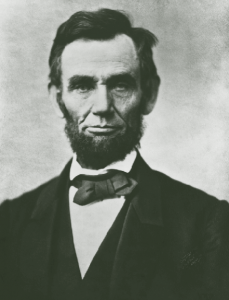
Abraham Lincoln—the Irish did not share the aspirations of Abraham Lincoln and his Republican Party in 1860, fearing that abolition would irreparably damage the precarious position of the Irish-American in society.
By the 1850s the influx of former Southern slaves to the growing cities of the North meant that employers no longer had to rely on the despised Irish immigrant—anti-Catholic and anti-Irish views were widespread, and employers were quick to realise the advantages offered by a black workforce. Many employers favoured these black Southern migrants over the ‘lazy papist immigrant’ owing to a widely held belief that former slaves had greater cause to appreciate their freedom and employment and would therefore work harder to ensure that they kept it. An ‘anybody but an Irishman’ mindset began to take root amongst many employers during the later 1850s, summed up by Lawrence Kohl: ‘Society’s contempt could not have been made clearer than it was in an advert for household help that sought applicants from any country or colour except Irish’. The phrase ‘No Irish need apply’ became an almost expected sight at the bottom of advertisements for jobs, and as this form of open discrimination increased, so did the poverty of the Irish.
Mutual animosity
Inevitably, as a result of this economic discrimination, the initial black resentment toward the Irish immigrants was reciprocated by the Irish community and brought about an open hostility between the two groups. Kohl suggests that the Irish felt a greater antipathy towards black Americans than they did towards the nativist ‘Know-Nothings’; contemporary observers remarked that ‘The Irish detested them [blacks] even more than the English or American whites who looked down on them from a position of social superiority’. Archbishop Hughes of New York (who would later see the Civil War as a perfect opportunity to integrate the Irish into WASP America) wrote that, as horrific an experience as slavery was, ‘at least the black slave was guaranteed something the Irish immigrant was not, three square meals a day and a roof over his head every night’. In 1861 the Irish priest Daniel W. Cahill wrote that ‘The negro slaves are far happier than the poor Irish, [and] who will therefore deny [that] the poor Irish cottier, with his life and death firmly in the hands of the cruel landlord, is not in a worse condition and is really a more degraded slave than the negroes of North America?’ Without suggesting that the Irish immigrant viewed African-American slaves with envy, they harboured no illusions that their lot was any worse than their own.

Frederick Douglass.
Some within the Irish community even went so far as to express open support for slavery and to call for its expansion into the Northern states. In 1854 the former Young Irelander John Mitchel announced that ‘We deny it is a crime, or a wrong, or even a peccadillo to buy slaves, to sell slaves or to hold slaves, to keep slaves at their work through flogging and other coercive measures’. The open Irish hostility towards black Americans again reared its head a few years later when the eagerness displayed by some Irish militia companies in helping to enforce the Fugitive Slave Act generated further tension and hatred between the Irish and African-American communities, and led several states to curb the extent of Irish recruitment into the militia.
In consequence, the Irish did not share the aspirations of Abraham Lincoln and his Republican Party in 1860, fearing that abolition would irreparably damage the precarious position of the Irish-American in society. Irish newspapers such as the Boston Pilot viewed the abolitionists and Republicans as ‘bigoted and persecuting religionists, desiring the extermination of Irish Catholics through fire and sword’. The Pilot regularly attacked Republican opposition to slavery as ‘endangering the whole fabric of society’, and placed the blame for the war firmly on Republican shoulders. Sections of the Irish press also attacked Lincoln, accusing him of treating the Irish ‘ungratefully and cruelly’ and seeking to ‘insult the entire Catholic population’.
Irish support for the Democratic Party
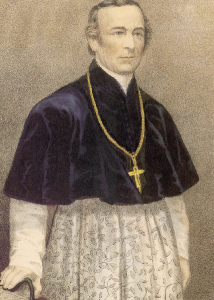
Archbishop Hughes of New York—‘at least the black slave was guaranteed something the Irish immigrant was not, three square meals a day and a roof over his head every night’. (Currier and Ives)
Most Irish-Americans would have supported the Democratic Party during its 1860 election campaign, based on its open declaration that the people of Ireland should be free from British oppression; they had no possible motive to support any candidate or party that would give equal status to their social and economic rivals. Thomas Craughwell sums up the majority view of the Irish:
‘The Irish identified the Republicans as the party of the abolitionists. The abolition of slavery, the Irish believed, was a direct threat to their economic status. In the event of wholesale abolition, the Irish feared they would be competing against four million people who would work for lower wages then themselves.’
This view has been supported by Christian Samito, who states that ‘many Irish loathed the thought of African Americans exercising political and other rights, and feared the consequences’. Contemporary writers claimed that ‘the Irish, being Democrats, naturally sympathised with the prevailing sentiment of the Southern States and their cause, regardless of the slavery issue’. Similarly, the idea that Irishmen would have fought for the equality of their social enemies in 1861 is severely challenged by such evidence; the idea that Irishmen were fighting in the Union ranks to secure the freedom of the slaves is misguided and naive. One veteran of the Irish brigade, David Cunningham, writing two years after the end of the war, notes that ‘the Irish soldier did not ask whether the coloured race were better off as bondsmen or freemen, he was not going to fight for an abstract idea’.
Slavery not an issue in most Irish war memoirs
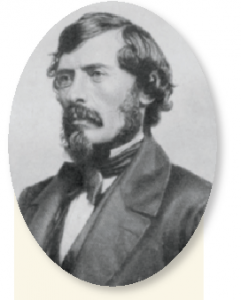
John Mitchel—‘We deny it is a crime, or a wrong, or even a peccadillo to buy slaves, to sell slaves or to hold slaves, to keep slaves at their work through flogging and other coercive measures’.
Slavery does not figure prominently in the memoirs of Irish soldiers: David Cunningham and James Sullivan, for example, neglect to mention the slavery issue in their accounts. Although it could be argued that these men sought to write regimental and not political histories, it still appears somewhat telling that at no point do they mention being involved in a moralistic and humanitarian campaign against slavery. It could be that they simply did not deem the slavery issue important enough to include in their works, or took it for granted that their audience would understand the slavery issue to the extent that they did not need to be bored with it any longer.
A more likely scenario is that the average Irish soldier simply did not care about the plight of the black slaves; indeed, the Union’s moral outrage on the issue of slavery had little relevance for the enlisted Irish. Perhaps one of the most telling examples of the attitudes displayed by ordinary enlisted Irishmen towards the abolitionist cause is presented to us by an unnamed Union soldier: ‘It has turned out to be an abolition war, ninety-nine out of one hundred soldiers say that if the abolitionists are going to carry on this war, they will have to do it with a new army. They say they came out here to fight for the Union, not a pack of Niggers!’
Irish attitudes did not soften with the outbreak of war. The high number of casualties suffered by many of the Irish Union regiments, coupled with the notable absence of black regiments, began to breed resentment amongst many within the Irish community. A feeling grew amongst the Irish that they were fighting for a community that had no urge to help itself. Peter Hogan notes that:
‘When the Civil War came, much ill will among Northern Whites was caused by the government’s delay in forming African-American troops. The Irish in particular expressed a desire to fight for the Union, but not to fight for the African-Americans when they were not fighting for themselves.’
As the war progressed, New York employers and the authorities began to use African-American strike-breakers to end civil disputes with Irish workers, thereby stoking the already glowing fire of ethnic division between the two communities. Striking Irish bitterly resented being blacklegged by a group for whom they believed their compatriots had died.
New York’s draft riot
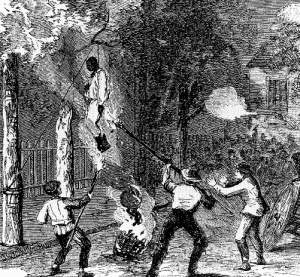
The lynching of an African-American on Clarkson Street by an Irish mob. (Harper’s Weekly, 21 July 1863)
The position of the Irish immigrant grew considerably worse after March 1863 saw the introduction of a Conscription Act, making all men between the ages of 20 and 45 eligible to be drafted into the Union army. Although a get-out clause allowed men to buy their way out of the draft for $300, very few within the Irish labouring class could afford such a sum. Once again the Irish began to blame the Republicans and the blacks for the outbreak of the conflict that had caused this injustice to be visited upon them. Irish men and women had already been compelled to watch their sons and husbands die on the battlefields of Antietam and Fredericksburg to defend the black community and Republican ideals; to force them into such a fate proved a step too far. On Monday 13 July 1863 New York descended into chaos, as a mob of predominantly Irish immigrants began to ‘loot the homes of wealthy Republicans and lynch blacks’. This Irish mob behaved in a similar fashion to the nativist mob that had launched a pogrom against the Irish in Philadelphia twenty years before. They burned down a home for orphaned coloured children and lynched former slaves from street lampposts. Archbishop Hughes, ‘himself no supporter of abolitionism’, was unable to stop the violence. It only ended once soldiers recently returned from Gettysburg intervened. The draft riot lasted for four days, left over 1,000 dead and caused millions of dollars’ worth of damage to New York City. (It remained the country’s worst example of mob violence until the ‘Rodney King’ LA riots, nearly 130 years later.) It stands as the most damning and violent embodiment of popular Irish attitudes towards their black counterparts during the Civil War period, confirming the view that Irish support for the Union cause had little to do with abolitionism. HI
Daniel Downer is an MA history student at the University of Ulster, Magee College.
Further reading
T. Craughwell, The Greatest Brigade (Massachusetts, 2011).
N. Ignatiev, How the Irish became white (New York, 1995).
C. Samito, Becoming American under fire (Ithaca, 2009).
















